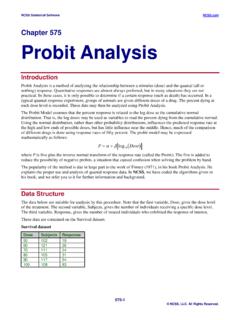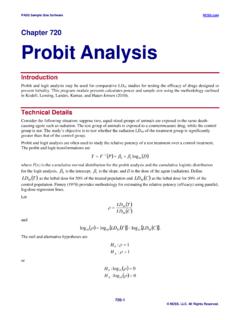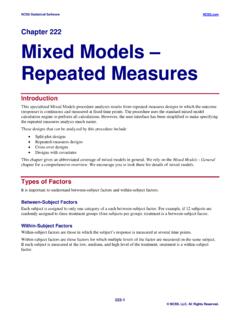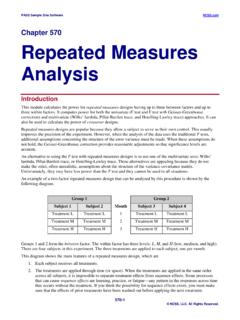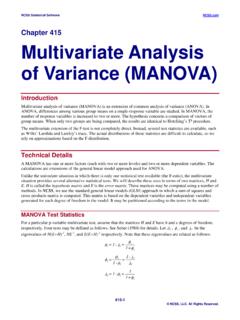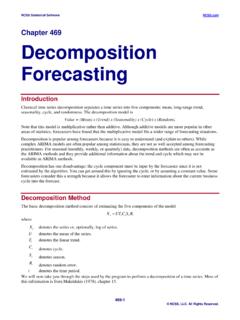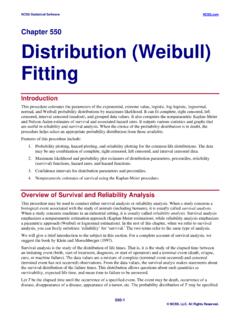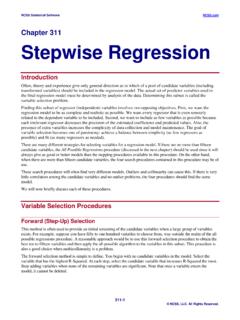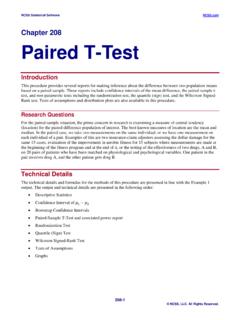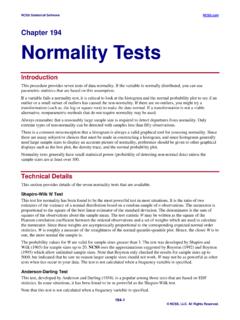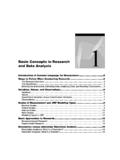Transcription of Bland-Altman Plot and Analysis - Statistical Software
1 NCSS Statistical Software 204-1 NCSS, LLC. All Rights Reserved. Chapter 204 Bland-Altman Plot and Analysis introduction The Bland-Altman (mean-difference or limits of agreement) plot and Analysis is used to compare two measurements of the same variable. That is, it is a method comparison technique. For example, an expensive measurement system might be compared with a less expensive one or an intrusive measurement system might be compared to one that is less intrusive. The technique is documented in a series of papers by J. Martin Bland and Douglas G. Altman (1983, 1986, and 1999). NCSS Statistical Software Bland-Altman Plot and Analysis 204-2 NCSS, LLC. All Rights Reserved. Repeatability An important part of method comparison is to understand how repeatable the measurement system is. This can only be understood by sampling each subject multiple times on the same method.
2 This provides for the Analysis of designs that include replicates. Technical Details for Three Designs There are three study designs that can be analyzed by this procedure. Each type has different input and different technical details and the output is not identical. The technical details of each design will be presented here. Design 1: Exactly one data-pair per subject This is the design that has been used for many years. In this design, each of the two measurement-methods is measured once on each subject at nearly the same point in time. A big drawback of this design is that no repeatability parameter can be computed. Data Structure For this design, the data are entered in two columns. X1 X2 57 53 63 69 66 63 74 76 77 75 77 79 78 77 79 77 80 81 81 82 81 81 82 83 82 81 83 85 84 83 85 74 86 88 86 87 86 82 87 88 Suppose you want to evaluate the agreement between a continuous random variable X1 and a second random variable X2 which each measure the same variable, such as blood pressure.
3 Assume that n paired observations (X1k, X2k), k = 1, 2, .., n are available. The Bland-Altman plot (1983) is formed by plotting the differences X1 - X2 on the vertical axis versus the averages (X1+X2)/2 on the horizontal axis. A horizontal line representing the bias is drawn at . Additional horizontal lines, known as limits of agreement, are added to the plot at 1. 96 and +1. 96 . The d s are the differences formed as d = X1 - X2. Sometimes the is replaced with 2 or with another value. Of course, represents the z-value used to form 95% limits for a unit-normal random variable. NCSS Statistical Software Bland-Altman Plot and Analysis 204-3 NCSS, LLC. All Rights Reserved. Bias The bias between the two tests is measured by the mean of the differences calculated in the usual fashion as =1 d =1 Limits of Agreement Limits of agreement between the two tests are defined by a 95% prediction interval of a particular value of the difference which are computed as follows 1.
4 96 where = 1 1 2 =1 Bland and Altman (1999) provide the following variances and confidence intervals for the bias and the limits of agreement, assuming that the differences are normally distributed. Variances = 2 1. 96 = 1 +1. 9622( 1) 2 Confidence Intervals Hence, 95% confidence intervals for the mean difference (the bias) are 1 /2, 1 The 95% confidence intervals for the limits of agreement are 1. 96 1 /2, 1 1. 96 and +1. 96 + 1 /2, 1 1. 96 These confidence intervals provide a measure of the precision of these values that aids in the interpretation of the plot. NCSS Statistical Software Bland-Altman Plot and Analysis 204-4 NCSS, LLC. All Rights Reserved. Design 2: Multiple replicates for each method, no pairing In this Bland-Altman design, each subject is measured several times (usually in immediate succession) on one method and then measured several times on the other method.
5 There is no natural pairing of the measures. In fact, the number of replicates does not have to be the same for each method. It is assumed that the overall response mean stays constant throughout the data gathering period. Data Structure For this design, all measurements for a specific subject are entered on one row. That is, each row represents a different subject. In the example below, there were two measurements of method X followed by three measurements of method Y. X1 X2 Y1 Y2 Y3 57 53 56 55 51 63 69 62 64 66 66 63 67 64 65 74 76 76 77 77 77 75 74 76 73 77 79 75 76 78 78 77 73 78 74 79 77 78 79 76 80 81 82 84 83 81 82 80 84 85 81 85 84 83 80 Limits of Agreement Calculation Suppose you want to evaluate the agreement between a continuous random variable X and a second random variable Y which each measure the same underlying variable, such as blood pressure. Assume that n subjects are available.
6 Variables X and Y are measured repeatedly on each subject. Variable X is measured mX times and variable Y is measured mY times. These measurements are not made in X, Y pairs. In fact, all measurements of one method are made in rapid succession followed by all measurements of the other method. The order in which the methods are measured is random for each subject. The following details come from Zou (2013). Data values xij and yij are assumed to follow one-way random effects models = + + and = + + It is assumed that the quantities axi, ayi, exij, and eyij are normal variates with means 0 and variances 2, 2, 2, and 2, respectively. Now, make the following computations. NCSS Statistical Software Bland-Altman Plot and Analysis 204-5 NCSS, LLC. All Rights Reserved. Step 1. Compute individual subject means and variances.
7 =1 x =1, =1 y =1, = , = =1 2= 2 1 =1, 2= 2 1 =1, 2= 2 1 =1 Step 2. Compute pooled estimates of the within subject random errors. =1 x =1, =1 y =1 2= 1 1s 2 =1, 2= 1 1s 2 =1 where = =1, = =1 Step 3. Compute the harmonic means of the replicate counts. = 1m =1, = 1m =1 Step 4. Compute the standard deviation of a difference. 2=s 2+ 1 1 2+ 1 1 2 Step 5. Finally, compute the limits of agreement. = /2s = + /2s where /2 is the value from the standard normal distribution that puts /2 in each tail. Usually, /2 is set to or rounded-off to 2.
8 Confidence interval estimation for LoA based on the delta method (1 - )% confidence intervals can be calculated for the lower and upper LoA values using a variance based on the delta method. This variance is computed using ( )= =s 2 + /222 2 s 2 2 1+ 1 1 2( 2)2 + 1 1 2 2 2 NCSS Statistical Software Bland-Altman Plot and Analysis 204-6 NCSS, LLC. All Rights Reserved. Confidence Intervals Hence, (1 - )% confidence intervals for the two LoA are /2 ( ) and /2 Confidence interval estimation for LoA based on the MOVER method The above confidence intervals are symmetric and may not by accurate for typical sample sizes. Zou provides the following adjusted confidence interval which simulation studies show to be more accurate in small to moderate sample sizes.
9 Step 1. Compute l and u as follows. = 2 1, = 2+ 1 where 1= s 2 1 1 1 2, 12 2+ 1 1 1 1 /2, 2 2 2+ 1 1 1 1 /2, 2 2 2 Step 2. Compute LME and RME as follows. = /22s 2 + /22 2 2 = /22s 2 + /22 2 2 Step 3. Compute the MOVER confidence intervals as follows. The (1 - )% MOVER confidence interval for the lower limit of agreement is , + The (1 - )% MOVER confidence interval for the upper limit of agreement is , + NCSS Statistical Software Bland-Altman Plot and Analysis 204-7 NCSS, LLC. All Rights Reserved. Design 3: Multiple replicates for each method obtained as pairs In this Bland-Altman design, each subject is measured by each method several times.
10 At each measurement point, a value for each method is obtained in rapid succession. These are referred to as measurement pairs. It is assumed that the overall response mean varies during the data gathering period. Data Structure For this design, each measurement pair is reported on a single row. Three columns of data are required: one with the subject value, one with the measurement of method 1, and one with the measurement of method 2. Subject X Y 1 53 56 1 69 62 2 63 67 2 76 76 2 75 74 3 79 75 3 77 73 4 77 78 4 81 82 4 82 80 4 85 84 Limits of Agreement Calculation Suppose you want to evaluate the agreement between a continuous random variable X and a second random variable Y which each measure the same underlying variable, such as blood pressure. Assume that n subjects are available. Variables X and Y are measured together repeatedly on each subject m times. Data values dij = xij - yij are assumed to follow a one-way random-effects model = + + It is assumed that the quantities ai and eij are normal variates with means 0 and variances 2 and 2, respectively.
